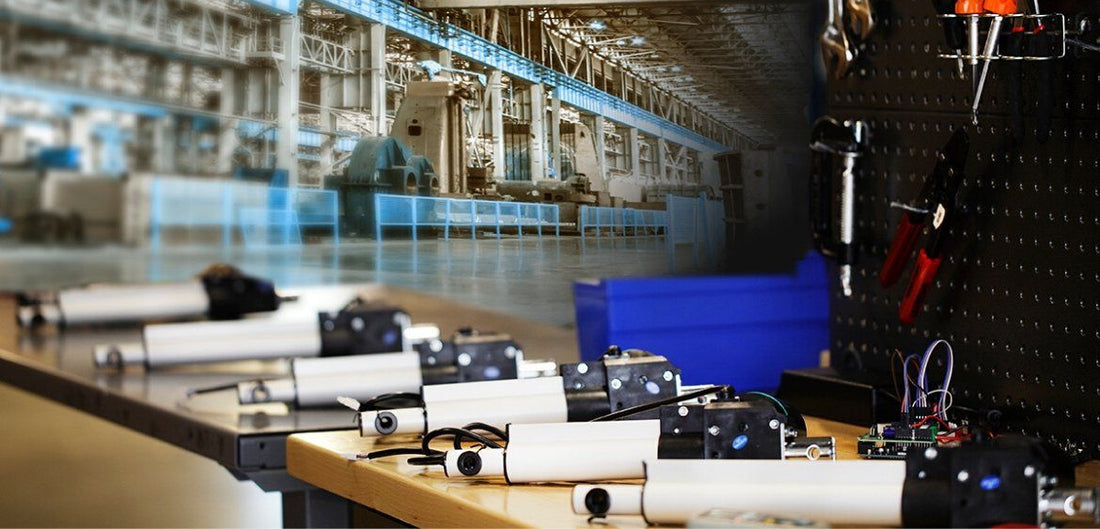Linear actuators can be powered by electricity, pressurized fluid, or air. In this post, we will break down the key advantages and disadvantages (pros and cons) of hydraulic, pneumatic, and electric linear actuators. Additionally, you will be able to see the key differences of an electric over hydraulic linear actuator or a pneumatic over electric linear actuator, for example.
Pros and Cons of Hydraulic Linear Actuators
Hydraulic linear actuators utilize a piston-cylinder configuration. An incompressible liquid from a pump fills the cylinder and forces the piston to move. With increased pressure, the piston moves linearly inside the cylinder, and the speed can be adjusted by changing the flow rate of the fluid. A high-speed hydraulic actuator is not only fast, but can supply a significant force. The piston returns to its retracted position by either a spring-back force or fluid being supplied to the opposite side.
Advantages of Hydraulic Linear Actuators
- Hydraulic actuators can hold a constant force without the pump supplying more fluid due to the use of an incompressible fluid.
- They can produce very high forces and speeds.
- It can produce high speeds.
Disadvantages of Hydraulic Linear Actuators
- Hydraulic fluid can leak, which leads to a loss in efficiency. This can also lead to cleanliness issues.
- Require many accompanying components including a fluid reservoir, pumps, motors, release valves, heat exchangers, and noise reduction equipment.
- High maintenance systems with numerous components to monitor constantly.
Pros and Cons of Pneumatic Linear Actuators
Pneumatic actuators function in a similar way to hydraulic actuators with the difference being the driving fluid is air rather than hydraulic fluid. The gas is compressed in a piston-cylinder setup which creates a linear force.
Advantages of Pneumatic Linear Actuators
- A pneumatic linear actuator is very simple. Most aluminium cylinders have optimal maximum pressure ratings which allows for a range of forces.
- A pneumatic linear actuator is often used in areas of extreme temperatures due to the safety of using air rather than hazardous chemicals or electricity.
- It is a low-cost option.
Disadvantages of Pneumatic Linear Actuators
- Pressure losses and the compressibility of air make pneumatic devices less capable than other linear motion methods. A compressor must run continuously to maintain the operating pressure even if there is no movement needed.
- Pneumatic actuators must be sized for a specific job in order to be efficient. This requires proportional sized valves, regulators, and compressors which raises the cost and complexity.
- The air can be contaminated by oil or lubrication, leading to downtime and maintenance.
Pros and Cons of Electric Linear Actuators
Electric linear actuators convert rotational motion into linear motion. Rotational motion is first generated by the electric motor. This high-speed rotational motion is then reduced by a gearbox to increase the torque that will be used to turn the lead screw. The turning of the lead screw results in linear motion of the acme drive nut. Think of it like driving a screw into a piece of wood, but rather than the screw moving towards the wood, the wood will be moving towards or away from the screw depending on the direction of rotation.
Advantages of Electric Linear Actuators
- Electric actuators offer the highest precision.
- Scalable for any purpose or force requirement.
- They can be easily networked and programmed quickly. Immediate feedback for diagnostics and maintenance is available.
- They provide complete control of motion, offering custom speeds, stroke lengths, and applied forces.
- They are quieter than pneumatic and hydraulic actuators.
Disadvantages of Electric Linear Actuators
- The initial cost is greater than that of pneumatic and hydraulic actuators.
- They are not suitable for all conditions, whereas a pneumatic actuator is safe in hazardous and flammable areas.
- The electric motors can be large.
Final Word
All three technologies have their place in the industry, but the flexibility of electric linear actuators, coupled with the fact that the price of electric components has been steadily decreasing over the years, makes them a more popular choice than they once were. Knowing what actuator is best for your application depends on your working environment.
If you require further assistance on selecting the right electric linear actuator for your application, give us a call at 1-800-676-6123, or email us at sales@progressiveautomations.com.




